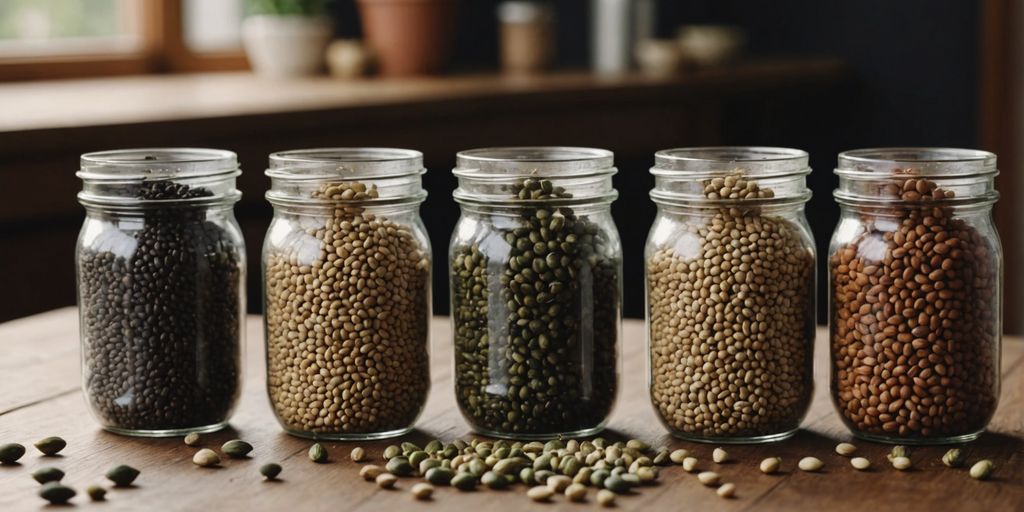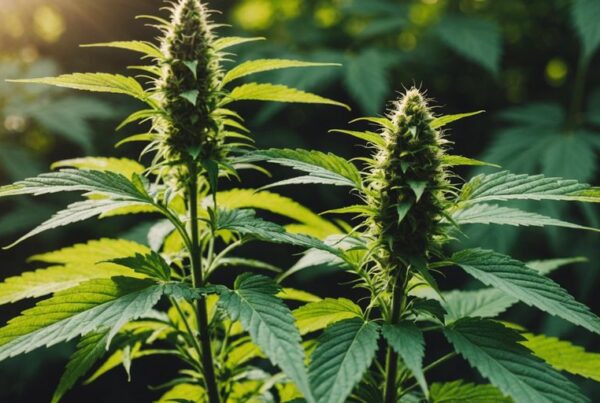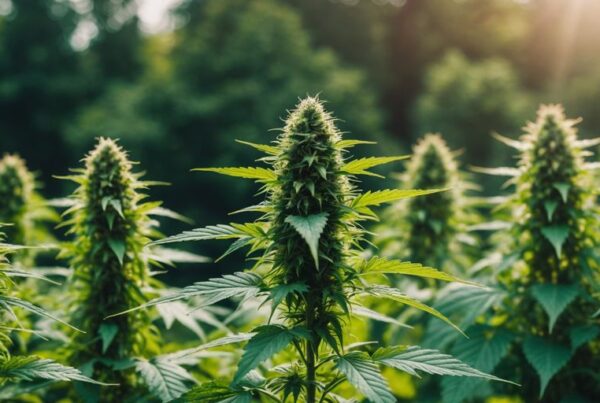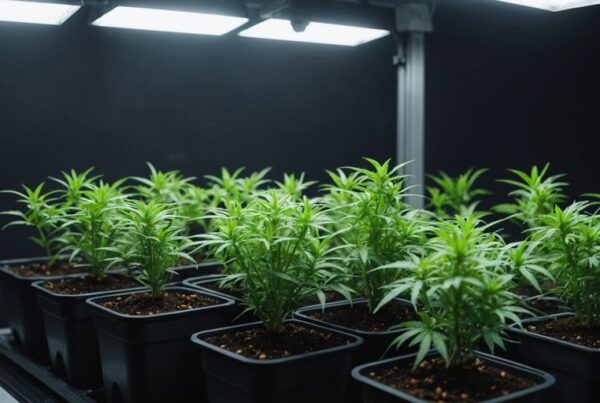Choosing the right container for storing seeds is crucial to keep them fresh and ready for planting. Whether you’re saving tiny tomato seeds or larger pumpkin seeds, using an airtight container can make a big difference. The goal is to protect the seeds from pests, light, and moisture. While store-bought seeds often come in paper envelopes, long-term storage needs a bit more care to ensure the seeds remain viable.
Key Takeaways
- Airtight containers are essential for keeping seeds fresh and viable for longer periods.
- Different types of containers like Mason jars, plastic sealable bags, and metal boxes can be used for seed storage.
- Always ensure seeds are thoroughly dried before storing to prevent mold and spoilage.
- Storing seeds in a cool, dark place can help maintain their viability.
- Using a variety of containers can help in organizing and managing different types of seeds.
Mason Jars
The simplest airtight long-term storage container is the ever-reliable glass Mason jar. With sizes ranging from 2-ounce spice jars to much larger gallons, Mason jars are easy to find and affordable. Try thrifting them from your local secondhand store or looking on sites such as Facebook Marketplace or Craigslist.
To keep your seed collection organized more compactly, try storing seed packets in photo storage cases. These stackable cases look tidy and provide a way to group similar varieties together.
Or, try themed gardens in Mason jars (which make great gifts!). Seeds for a spring garden, a salad garden, or a salsa garden could store well together in one jar.
All of my lettuce seed varieties fit into this gallon size mason jar.
However you organize your seeds, be sure to keep track of seed origination dates.
SEED VIABILITY
ORGANIZING SEEDS WITH THE MASON JAR STYLE
Mason jars allow you to store seeds in smaller units. For example, you could store short-lived seeds in the freezer so you can ensure their viability until the next growing season, while longer-lived seeds may store okay under the bed or in a cupboard.
How you organize your Mason jars will depend on your storage needs and how many seeds you’re storing. If you’re a tomato lover, store all of your tomato varieties together in one Mason jar.
Dividers can help you find things even quicker. Seeds of a certain type can be catalogued in order of their origination date, so older seeds get used first.
A plastic shoe box transforms into a card catalog style seed organization box.
Would you like FREE resources such as calendars, checklists, and planting worksheets to help you get organized?
You’ll get these bonus materials with your purchase of my award-winning book, The Suburban Micro-Farm!
ORGANIZING SEEDS WITH THE MASON JAR STYLE
Seeds should be stored in air tight containers. This can be achieved in a lot of different ways, but the idea is to protect the seeds from unwanted moisture, light and pests that may try and take up residence among your nutrient rich seeds. Mason jars are a great option for storing seeds that are loose or even storing seed packets. Seed packets can also be organized in plastic, sealable bags and then be stowed away in a Tupperware or other plastic or metal container. If humidity or moisture is a problem
Plastic Sealable Bags
Plastic sealable bags are a popular choice for storing seeds due to their convenience and affordability. These bags are great for short-term storage but may not be the best option for long-term use as they can let some air and moisture in over time.
To ensure your seeds stay dry, it’s important to remove as much air as possible before sealing the bag. Double-check to make sure there’s no moisture trapped inside. For added protection, you can place the sealed bags in a Tupperware or other plastic or metal container.
To absorb excess moisture, add some desiccant (drying agent) to the bottom of your storage container. Silica gel packets, which are reusable, work well for this purpose.
If you live in a humid area, using silica gel packets can help manage excess moisture. These little packets are similar to what you may find in a pair of shoes or a shipped garment. They can be reused season after season, making them a cost-effective solution.
For extra protection from light, consider using small ziptop bags. Just remember to keep your seeds very dry, as moisture is the most important cue for seeds to start growing.
Tupperware Containers
Tupperware containers are a popular choice for storing seeds due to their durability and ease of use. Every one touch fresh™ container has an airtight seal that closes with just one press. This feature ensures that your seeds remain fresh and viable for longer periods.
To maximize the effectiveness of Tupperware containers, consider the following tips:
- Use sealable bags inside the Tupperware to provide an extra layer of protection.
- Add silica gel packets to manage excess moisture, especially if you live in a humid area.
- Label each container clearly to keep your seed collection organized.
Tupperware containers are not only practical but also help in keeping your seeds safe from pests and environmental factors.
While Tupperware containers are excellent for short-term storage, it’s important to check them periodically to ensure the seals remain intact and no moisture has seeped in. This will help maintain the quality of your seeds over time.
Metal Seed Storage Boxes
Metal seed storage boxes are a great option for keeping your seeds safe and organized. These boxes are often made from durable materials like powder-coated galvanized steel, which ensures they are robust and long-lasting. They are perfect for storing a small quantity of seeds within easy reach, making them ideal for gardeners who need to access their seeds frequently.
One of the best things about metal seed storage boxes is that they protect your seeds from moisture, light, and pests. This is crucial for maintaining the viability of your seeds over time. You can also use silica gel packets or homemade packets of powdered milk, rice, or rice hulls inside the boxes to trap any excess moisture.
A vintage-inspired metal seed storage box can add a touch of charm to your gardening supplies. It reminds me of an old-fashioned recipe box my grandmother used to keep on the kitchen counter.
If you want to keep your seeds organized, consider labeling the boxes and arranging them in a designated area. This could be a corner of your pantry or even a converted dresser or nightstand. Keeping your seeds in a compact and stylish way not only makes them easy to find but also adds a bit of flair to your storage solutions.
Glass Kilner-Style Jars
Glass Kilner-style jars are a fantastic option for storing seeds. These jars are known for their airtight seal, which helps keep seeds fresh and viable for longer periods. The Kilner® clip top jar is perfect for preserving healthy, homegrown foods. The contemporary square jar shape is space-saving, making it ideal for pantry storage.
Benefits of Using Kilner-Style Jars
- Airtight Seal: The clip top ensures that no air gets in, which is crucial for maintaining seed viability.
- Durability: Made from high-quality glass, these jars are built to last.
- Space-Saving Design: The square shape of the jar allows for efficient use of storage space.
Tips for Storing Seeds in Kilner-Style Jars
- Label Your Jars: Always label your jars with the type of seeds and the date of storage.
- Store in a Cool, Dark Place: Keep the jars in a pantry or cupboard to protect the seeds from light and heat.
- Group Similar Seeds Together: This makes it easier to find what you need and keeps your collection organized.
For those who love gardening, using Kilner-style jars can make seed storage both practical and visually appealing. The clear glass allows you to see the contents easily, and the airtight seal ensures your seeds stay fresh for the next planting season.
Seed Envelopes
Seed envelopes are a simple and effective way to store your seeds. Our seed envelopes are designed to protect and preserve your seeds, ensuring maximum germination and a bountiful harvest. Made from high-quality and durable paper, they provide a breathable environment that helps keep seeds dry and safe from mold.
When using seed envelopes, it’s important to ensure that the seeds are completely dry before storing them. This prevents any moisture from being absorbed by the paper, which could harm the seeds. If you have a large number of seeds, consider dividing them into smaller collections. This way, if one batch goes bad, it won’t affect the others.
Seed envelopes are also great for organizing your seeds. You can label each envelope with the type of seed and the date it was collected, making it easy to keep track of your collection. For added protection, you can store the envelopes in a larger airtight container or a three-ring binder with clear plastic storage sheets.
Seed envelopes are a versatile and practical option for any gardener looking to keep their seeds fresh and viable.
Airtight Plastic Containers
Plastic containers with seals are suitable for storing seeds, but they allow some air and moisture in over time. For short-term storage, using two zip lock bags can prevent air leaks. To absorb excess moisture, add a drying agent like desiccant at the bottom of the container. Airtight containers are crucial for keeping out environmental moisture and condensation. Using silica gel packets or homemade moisture traps like powdered milk or rice can help protect the seeds. Storing seed packets in a larger glass jar with multiple paper packets is a good technique. The simplest airtight storage container is the glass Mason jar, available in various sizes. Storing seed packets in photo storage cases can help organize the collection compactly and group similar varieties together.
Wax Envelopes
Wax envelopes are a fantastic option for storing seeds. They provide a natural barrier against moisture, which is crucial for keeping seeds dry and viable. These envelopes are especially useful for short-term storage or for sharing seeds with friends and family.
Benefits of Wax Envelopes
- Moisture Resistance: Wax envelopes are coated with a thin layer of wax, making them resistant to moisture. This helps in keeping the seeds dry and prevents mold growth.
- Versatility: Customers like the versatility of these envelopes. They mention it’s perfect for collecting seeds, saving seeds, and seed swaps.
- Eco-Friendly: Unlike plastic bags, wax envelopes are biodegradable and environmentally friendly.
Tips for Using Wax Envelopes
- Label Clearly: Always label the envelopes with the type of seed and the date of storage.
- Store in a Cool, Dry Place: To maximize the lifespan of your seeds, keep the wax envelopes in a cool, dry location.
- Check for Moisture: Before sealing the envelope, make sure the seeds are completely dry to avoid any moisture-related issues.
Wax envelopes are a simple yet effective way to store seeds, offering both protection and sustainability.
Paper Envelopes
Paper envelopes are a simple and effective way to store seeds. They are easy to label and organize, making them a popular choice among gardeners. However, it’s crucial to keep them dry because the paper can absorb moisture, which can harm the seeds.
Advantages
- Cost-Effective: Paper envelopes are inexpensive and readily available.
- Easy Labeling: You can write directly on the envelope, making it easy to identify the seeds inside.
- Eco-Friendly: They are biodegradable and environmentally friendly.
Disadvantages
- Moisture Sensitivity: Paper can absorb water, which can damage the seeds. It’s essential to store them in a dry place.
- Limited Durability: Paper envelopes can tear or get damaged easily.
Tips for Using Paper Envelopes
- Keep Them Dry: Store the envelopes in a dry place to prevent moisture absorption.
- Use Silica Gel Packets: Place a silica gel packet inside the storage container to absorb any excess moisture.
- Label Clearly: Write the seed type and date of storage on the envelope for easy identification.
- Store in a Larger Container: Tuck multiple paper envelopes into a larger airtight container for added protection.
Paper envelopes are a great option for short-term seed storage, especially if you plan to use the seeds within a few months. Just make sure to keep them dry and well-labeled for the best results.
Vintage Metal Recipe Boxes
If you want to store a small quantity of seeds within easy reach, a vintage-inspired metal seed storage box might be just what you’re looking for. It reminds me of an old-fashioned recipe box my grandmother used to keep on the kitchen counter—perfect for storing sprouting seeds since I rotate through those all year long.
- Designate a corner of a pantry for seed storage jars.
- Hang a cute shelving unit on a wall in a spare room or your office—and fill the shelves with jars boasting color-coordinated labels.
- Repurpose old-fashioned bread boxes and fill with frequently used sprouting seeds.
- Fill vintage suitcases with seed storage containers and stack them in a corner for visual appeal.
A thrifted basket seed box DIY can also be a fun project. Come on in, and let me show you how I DIYed a thrifted basket into a vintage-inspired seed box.
Conclusion
In summary, the best way to keep your seeds fresh and ready for planting is by using airtight containers. Whether you choose glass jars, plastic bins, or metal boxes, the key is to keep out moisture, light, and pests. Remember to dry your seeds well before storing them to avoid mold. For the best results, store your containers in a cool, dark place, like a fridge or a basement. By following these simple steps, you can ensure your seeds stay viable and ready for the next growing season.
Frequently Asked Questions
What is the best container for storing seeds?
The best container for storing seeds is an airtight one. This could be glass, metal, or plastic. The goal is to keep moisture, light, and pests away from the seeds.
Why should seeds be stored in airtight containers?
Airtight containers protect seeds from moisture, light, and pests. This helps keep the seeds fresh and increases their chances of germinating when planted.
How should I prepare seeds before storing them?
Make sure the seeds are completely dry before storing them. Any moisture can cause mold to grow, which will ruin the seeds.
Can I store seeds in the refrigerator?
Yes, storing seeds in the refrigerator can extend their life. The cool temperature slows down the aging process, but make sure the container is airtight to keep moisture out.
What are some common containers for storing seeds?
Common containers include Mason jars, plastic sealable bags, Tupperware containers, metal seed storage boxes, glass kilner-style jars, and various types of envelopes.
How long will seeds last in storage?
The lifespan of seeds in storage can vary, but if stored properly in a cool, dry place, they can last for several years.








